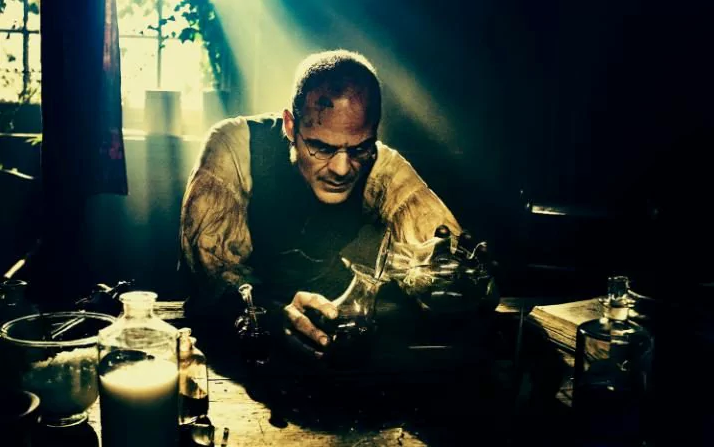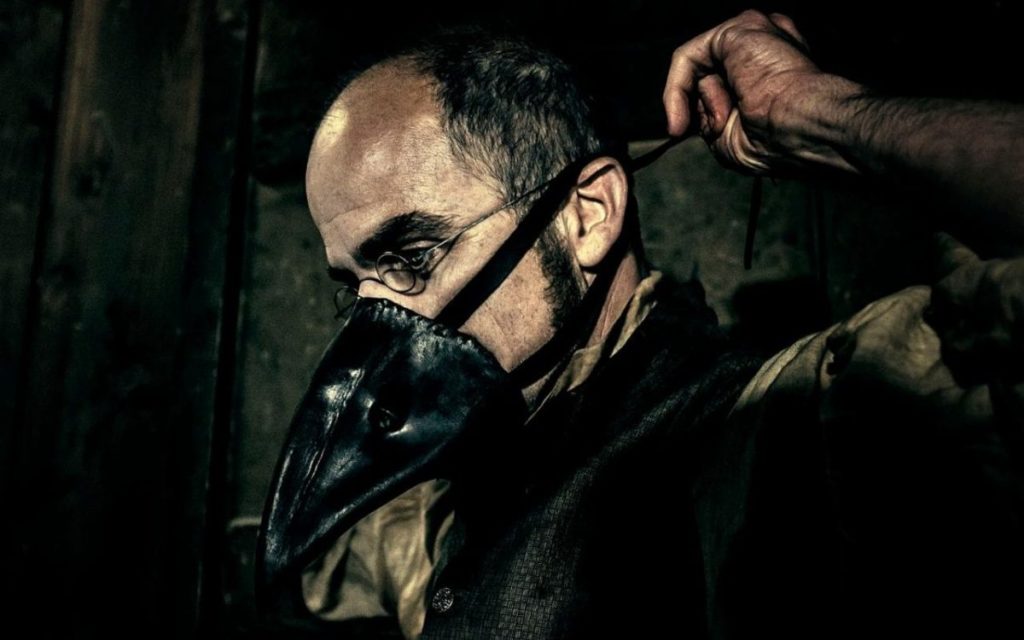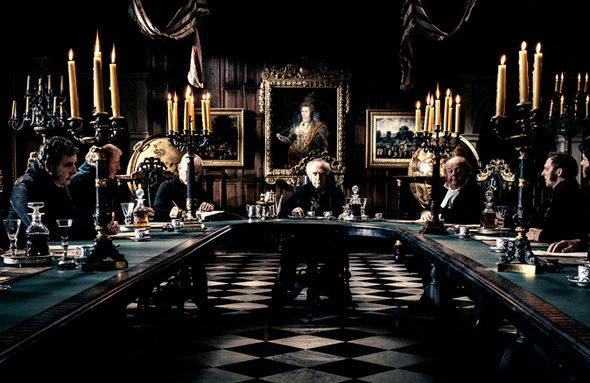
**SPOILER WARNINGS**
I was excited about BBC1’s gritty historical drama Taboo. After all, it was created by Steven Knight (the man behind Peaky Blinders, which I love), Tom Hardy and Hardy’s dad. Knight wrote it, as fans of Peaky Blinders will immediately spot – the troubled amoral “hero”, everything leading up to a nail-biting and very satisfying final episode. And I really loved the character Lorna Bow – an actress and young widow.
But I have to say that watching the series, I spent half the time entertained (sometimes when I should have been and sometimes when the concept’s daftness overwhelmed me – the Tom Hardy Grunt Counter springs to mind), and half the time feeling rather irritated.
I can’t help it. I know my history, and… well…. Shall we say that I identified a couple of historical errors, which, as someone who knows about these things, I really feel I need to point out.[1]There were other things I found rather… strange, but other people have written about those aspects. Such as, does Tom Hardy look convincingly like someone who is part white British and part … Continue reading
Tests for arsenic
An important plot point to kick the story off is the discovery in the first episode that Horace Delaney, father of Hardy’s character, James Delaney, died of arsenic poisoning. Taboo is set in 1815, when arsenic testing was in its infancy. When the Marsh test came along in 1836, followed by the Reinsch test in the early 1840s, toxicologists were elated – here at last were quicker, more reliable methods.

Robert Christison’s 1832 On Poisons, the toxicologists’ Bible of the time, tells readers in no uncertain terms that arsenic analysis was very difficult and time consuming. It might be straight forward to test it in its pure state, but add in the inconvenience of “organic matter” (ahem – stomach contents and bits of dead people), and it becomes very difficult indeed.
Christison rejected the late eighteenth-century method which relied solely on the analyst’s sense of smell – arsenic gave off a garlic-like odour when burnt. This wouldn’t do because it was only in its metallic state when it gave off the smell, and it was the oxide of arsenic that was used as a murder weapon. Besides which, sniffing in the laboratory is an unreliable analytical method. Another test involved the use of ‘cabonaceous matter’ heated between two copper plates, which would produce a silver alloy if arsenic was present – this required at least a grain of arsenic (65mg) to be present.
His own preference was for the reduction test, which meant heating the oxide in a tube. This separated out the metal, making it visible to the naked eye. If the oxide was in a liquid, hydrogen sulphide gas was used, creating arsenic trisulphide, and water would arise when the displaced hydrogen reacted with the remaining oxygen. Then the arsenic trisulphide could be subjected to the reduction method to separate out the metal. Christison also recommended using chemical reagents which could produce a coloured precipitate, and that three different ones should be use to cancel out any fallacies.
But add in the aforementioned “organic matter” and these tests become very difficult. The precipitates were identified by colour, which organic matter could interfere with. And to perform the reduction test, the oxide would have to be separated out from the matter before the test.
The separation was a long process – Christison boiled the suspect fluid and filtered out the solids, to gain a transparent solution. This could take up to thirty-six hours. Various chemicals had to be used to remove “animal matter” (I don’t think I need elaborate on what that is) from the liquid.
Bear in mind that when Christison was making his analyses, he wasn’t just swilling about stomach contents in a glass jar but analysing human organs, which had to be liquified in order to free the arsenic for the tests. It was unpleasant, time-consuming work.
Come back in twenty minutes
So imagine my surprise when James Delaney pops by St Bart’s Hospital and asks a physician to perform an analysis of his father’s remains. The physician decides to use something which sounds almost like the Rose test, and he tells Delaney “Come back in twenty minutes” – or words to that effect.
TWENTY minutes?
It’s 1815. You’d be lucky if the physician had anything to show Delaney in twenty hours, let alone minutes! In the 1840s, Alfred Swaine Taylor was asked to perform a test in court to ascertain whether or not white powder in a bag was arsenic. This was pure powder, no “animal matter” involved. He left the witness box, went into a private room, performed his test (presumably the Reinsch test, as the equipment was basic and easily portable) and announced that it was indeed arsenic. That’s half an hour, by one of the leading toxicological analyists of his day, using a more advanced test than that of Rose, on pure arsenic.
Twenty minutes in 1815 on a corpse? Erm… no.
The physician tells Delaney that he’ll perform his test using potassium oxide, calcium oxide and nitric acid. He presumably meant potassium carbonate, not oxide, which in 1815, a scientist is likely to have called carbonate of potass anyway. He would be using the Rose test, which was developed in 1806. At least it’s historically accurate, because if he’d claimed to be using the Marsh or Reinsch test in 1815, I would have had no choice but to pen a strongly worded missive to Points of View.
Writing in 1832, Christison devotes only one paragraph to the Rose test:
Rose, a German chemist, proposed some time ago the process which is still generally adopted in Germany – consisting in the formation of an arsenic of lime, and its subsequent reduction with charcoal and boracic acid. …on the whole [it] is a good one, though not equal to that by sulphuretted-hydrogen.
He was impressed by the Rose test, but only up to a point. And it’s clear that the test involved two stages. It would’ve taken a hell of a lot longer than twenty minutes to perform.
But those twenty minutes gave Delaney time to go into a room full of dead bodies and have the mother of all flashbacks.
And this is the problem with science on the telly or in films. Science takes time. Science holds up the plot. Delaney has one question to ask – Was my father, as I suspect, poisoned? – and he doesn’t have time in the narrative arc to wait around for two weeks until the physician replies, “My results are inconclusive – he might’ve been poisoned by a small dose but I can’t know that in 1815 because the tests available to me aren’t sensitive enough.”
It’s essentially CSI: Tailcoat.
That’s not how arsenic works
After performing his arsenic analysis in record time, the physician discusses the mechanism of arsenic poisoning with Delaney. Apparently, he could tell that Horace Delaney had been poisoned with small doses over a long period of time – slow-poisoning, as it was known, but that at the end, he was given large doses, and this made him mad and ultimately killed him.
That’s… intriguing.
Especially as he seemed to be testing just stomach contents, which would only show you if someone had consumed arsenic in the past day or so. Not months. If you took your time and analysed many organs, as toxicologists such as Christison and Taylor did, then you could find arsenic all over a body; the heart, the brain, as well as in digestive organs. But working just on stomach contents, you couldn’t be that specific, identifying that they had been slow-poisoned to start with and then bumped off with an increased dose. And to be honest, even if you did analyse all the organs, in 1815, it’s unlikely the tests available would have been sensitive enough to detect the tiny traces left by slow-poisoning.
We are told that the dose was increased towards the end, and that this made Horace Delaney mad. I’m not sure about this. Slow-poisoning might, as increasing amounts of arsenic built up in the brain, affecting its function – it has been claimed that this caused or exaggerated King George III’s mental illness, from the medicines he was taking.[2]I’m tempted to look at this more closely because all the references I can find to arsenic and madness point to King George III. In my own reading of arsenic poisoning, madness doesn’t … Continue reading But if you suddenly increase the dose, it wouldn’t make them mad – it would give them a burning throat and unbearable stomach pain as the arsenic leaves ulcerations behind in the tissues. As the body tries to rid itself of the irritant, the victim vomits and has terrible diarrhoea. They’re dead in anything from a few hours to a few days. The pain is such that victims are reported as raving mad, but that’s down to the pain of the symptoms, and it’s not of long duration.

And, in case you’re wondering, if someone had terrible vomiting and diarrhoea, they might not have much in the way of stomach contents left to test. Hence the need to analyse organs for the arsenic that had been absorbed by the body. Which in 1815 wasn’t very easy to do.
But how many other people watching Taboo know this? Not that many, I would suspect. The ins and outs of arsenic poisoning and its analysis in the nineteenth-century is a rather specialist area. And yet, I knew, and it annoyed me.
Miasma, cholera and – are you sure they had those in 1815?

Later in the series, after I’d gnashed my teeth over the arsenic, Delaney scares everyone by telling them there’s a cholera epidemic, so that he can transport explosives (Steven Knight likes explosives) without interference. Oh my!
Firstly, let me tell you that in the nineteenth-century, the medical profession knew two different sorts of cholera. “Asiatic cholera”, which is what we know of today as cholera, and “English cholera”, which was used to describe a violent upset stomach (sometimes arsenic poisoning was misdiagnosed as English cholera). It was never clear which kind of cholera Delaney had decided to scare everyone with, but I suppose it’s implied that it’s what we’d know of as cholera today.
There was no cholera epidemic in Britain in 1815. In fact, Asiatic cholera was yet to visit these shores in 1815, but as the disease was known in the Indian subcontinent, British people returning from the colonies would have had experience of the disease and fear of it is entirely plausible – so I don’t necessarily have a problem with the idea of the cholera scare.[3]The first pandemic was in 1817, but the disease didn’t arrive in Britain until the end of 1831. 1832 is usually given as the year because this is when it arrived in London, but it actually … Continue reading
But what I do have a problem with is a medical professional, in 1815, wearing a plague doctor’s stuffed beak.
Yes, in 1815, miasma theory was still the prevailing theory about how disease spread. This is the “bad air” theory of disease, which is at least logical even if it’s wrong – that disease prevails where smells are bad, therefore disease must be in the air. It was why plague doctors wore beaks stuffed with nicely smelling things because they believed it was keeping the bad smells at bay. What it probably did was stop them absorbing any nasties when plague victims sneezed on them.
But I find it difficult to believe that a medical professional, working in a major hospital in London, would’ve worn a plague doctor’s beak in 1815.
Later in the nineteenth-century, the miasma theory would be proved wrong (even Alfred Swaine Taylor had a hand in striking its death knell, when he wrote a paper in 1832 about the death of a nurse at St James’ Infirmary during the cholera epidemic which could not be explained by “miasma”). Yet even if the medical profession still held to the miasma theory when it came to the spread of disease, they had passed through the Age of Enlightenment. Stuffed beaks and big coats and wide-brimmed hats for plague doctors were a relict of the past. Medical gentlemen passed through the world as gentlemen, and when “miasma” presented itself, they held a scented (possibly silk-edged) handkerchief to their faces.
And, whilst we’re on the subject – Delaney’s father died at St Bart’s. But, in 1815, a gentleman would not have done. They were for poor people; he’d have paid for medical attendants at home.
The Court of Chancery, what’s that?
Property and ownership is an important part of Taboo‘s plot. Land in America inherited by Delaney and his sister becomes hugely valuable, and the East India Company are determined to get hold of it by being as evil as they possibly can.

The land was to be left equally between Delaney and his sister, according to their father’s will (which I seem to remember they couldn’t find to start with and then it turned up – or something. Or perhaps that was a certificate of ownership of the land. There were lots of bits of paper floating about). At one point, someone suggests that a way round all this testosterone fuelled grunting about who owns what is to just destroy the will. And someone responds – “oh god no, he’s the son, he’ll inherit EVERYTHING!”
Erm… no.
I have vast experience of wills from this period, thanks to my genealogical research. Wills held at county record offices portioning off farms here and there, Prerogative Court of Canterbury wills of wealthy merchants and dukes, Court of Chancery wranglings…. If someone died intestate, which is what would happen if the will was never found, their estate would be divided up equally among their heirs. In the case of a man who has two “lawful” children, the estate would be divided equally between them, regardless of their gender. It might need to go to Chancery, especially if other relatives decided that they should have a slice of the cake as well, but the fact remains – the son does not automatically inherit everything.
Perhaps people have this idea thanks to primogeniture and the passing of country houses through families, but this is the result of an entail. I’ve seen these in wills for my own family, where someone will leave the manor of such-and-such to a son, and they specifically state that the manor is then to pass to the eldest lawful male heir of that son. One area of Essex, just to be contrary, demands that certain kinds of manorial property descends to the youngest son. Being the middle son sucks.
When it emerged that Delaney’s father had a young wife who wasn’t accommodated by the will, then at that moment, were this reality (and fortunately it’s not), a Chancery battle would have ensued.
I found it completely unbelievable that Delaney’s brother-in-law, who is presented as a gentleman (albeit a complete arse), wouldn’t have even once mentioned taking the suit to Chancery. Unless he thought the East India Company would interfere with the workings of the Court. I’ve seen people go to Chancery over a heap of old brass saucepans, so the idea of him not mentioning Chancery once – even as a threat to Delaney – was, to me, ahistorical.
Yes, but, Helen, it’s only television
It’s not easy watching period dramas when you know stuff about the past. And I suspect it’s not easy making period dramas, when among your audience, you’re aware that there are people who know about the period you’re basing your drama in.
I perfectly understand that dramatic licence is necessary sometimes – the huge long time the arsenic analysis would’ve actually taken in 1815 would’ve slowed down the pace; the plague doctor mask looked really sinister; the property dispute couldn’t go to Chancery as it robs Taboo of its entire thrust and turns it into Bleak House.
I know, I know – if you want accurate history, go and read a book, don’t base everything you know about the past on historical dramas. But unfortunately there are people will. The reputation of men such as Taylor and Christison are affected by these sorts of inaccuracies in dramas – How could it take them so long to do their tests later in the century when it only took twenty minutes in 1815? It’s like the CSI Effect, which legal professionals face now when presenting forensic evidence to a jury who think they know all about forensics because they saw it (presented inaccurately) on the telly.
I find history fascinating, and I like watching period dramas, but I find myself pulled out of the spell of good drama because, to paraphrase Alan Partridge, you’re getting history wrong.
Footnotes
| ↑1 | There were other things I found rather… strange, but other people have written about those aspects. Such as, does Tom Hardy look convincingly like someone who is part white British and part First Nations? |
|---|---|
| ↑2 | I’m tempted to look at this more closely because all the references I can find to arsenic and madness point to King George III. In my own reading of arsenic poisoning, madness doesn’t come up. You might be confused and exhausted but full-on paranoia and raving – no. Only a few months ago, a theory was put afloat that Jane Austen had suffered from arsenic poisoning too, the only evidence being the thickness of the lenses in her glasses! The leap of logic leading to this theory is that her eyesight got worse as the years went by, and she might have developed cataracts, and these might have been caused by arsenic. Is there no historical mystery that can’t be solved by suggesting the person in question was exposed to arsenic? |
| ↑3 | The first pandemic was in 1817, but the disease didn’t arrive in Britain until the end of 1831. 1832 is usually given as the year because this is when it arrived in London, but it actually arrived in Scotland at the end of 1831. We owe it to the people who died to get the year right. It came back again in 1849, killing far more people that it had seventeen years earlier. |